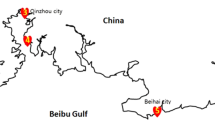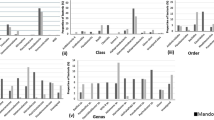Abstract
The microbial community plays an essential role in the high productivity in mangrove wetlands. A proper understanding of the spatial variations of microbial communities will provide clues about the underline mechanisms that structure microbial groups and the isolation of bacterial strains of interest. In the present study, the diversity and composition of the bacterial community in sediments collected from four locations, namely mudflat, edge, bulk, and rhizosphere, within the Mai Po Ramsar Wetland in Hong Kong, SAR, China were compared using the barcoded Illumina paired-end sequencing technique. Rarefaction results showed that the bulk sediment inside the mature mangrove forest had the highest bacterial α-diversity, while the mudflat sediment without vegetation had the lowest. The comparison of β-diversity using principal component analysis and principal coordinate analysis with UniFrac metrics both showed that the spatial effects on bacterial communities were significant. All sediment samples could be clustered into two major groups, inner (bulk and rhizosphere sediments collected inside the mangrove forest) and outer mangrove sediments (the sediments collected at the mudflat and the edge of the mangrove forest). With the linear discriminate analysis scores larger than 3, four phyla, namely Actinobacteria, Acidobacteria, Nitrospirae, and Verrucomicrobia, were enriched in the nutrient-rich inner mangrove sediments, while abundances of Proteobacteria and Deferribacterias were higher in outer mangrove sediments. The rhizosphere effect of mangrove plants was also significant, which had a lower α-diversity, a higher amount of Nitrospirae, and a lower abundance of Proteobacteria than the bulk sediment nearby.





Similar content being viewed by others
Explore related subjects
Discover the latest articles and news from researchers in related subjects, suggested using machine learning.References
Aburto-Oropeza O, Ezcurra E, Danemann G, Valdez V, Murray J, Sala E (2008) Mangroves in the Gulf of California increase fishery yields. P Natl Acad Sci USA 105:10456–10459
Zhou HW, Wong AHY, Yu RMK, Park YD, Wong YS, Tam NFY (2009) Polycyclic aromatic hydrocarbon-induced structural shift of bacterial communities in mangrove sediment. Microb Ecol 58:153–160
Sahoo K, Dhal NK (2009) Potential microbial diversity in mangrove ecosystems: a review. Indian J Mar Sci 38(2):249–256
Lopez-Fuentes E, Ruiz-Valdiviezo VM, Martinez-Romero E, Gutierrez-Miceli FA, Dendooven L, Rincon-Rosales R (2012) Bacterial community in the roots and rhizosphere of Hypericum silenoides Juss. 1804. Afr J Microbiol Res 6:2704–2711
Doornbos RF, van Loon LC, Bakker PAHM (2012) Impact of root exudates and plant defense signaling on bacterial communities in the rhizosphere. A review. Agron Sustain Dev 32:227–243
Guo CL, Zhou HW, Wong YS, Tam NFY (2005) Isolation of PAH-degrading bacteria from mangrove sediments and their biodegradation potential. Mar Pollut Bull 51:1054–1061
Zhou HW, Guo CL, Wong YS, Tam NFY (2006) Genetic diversity of dioxygenase genes in polycyclic aromatic hydrocarbon-degrading bacteria isolated from mangrove sediments. FEMS Microbiol Lett 262:148–157
Staley JT, Konopka A (1985) Measurement of in situ activities of nonphotosynthetic microorganisms in aquatic and terrestrial habitats. Annu Rev Microbiol 39:321–346
Holguin G, Guzman MA, Bashan Y (1992) Two new nitrogen-fixing bacteria from the rhizosphere of mangrove trees: their isolation, identification and in vitro interaction with rhizosphere Staphylococcus sp. FEMS Microbiol Ecol 101:207–216
Bashan Y, Holguin G, Lifshitz R (1993) Isolation and characterization of plant growth-promoting rhizobacteria. In: Glick BR, Thompson JE (eds) Isolation and characterization of plant growth-promoting rhizobacteria. CRC Press, Boca Raton, FL, pp 331–245
Muyzer G, Smalla K (1998) Application of denaturing gradient gel electrophoresis (DGGE) and temperature gradient gel electrophoresis (TGGE) in microbial ecology. Anton Leeuw Int J G 73:127–141
Urakawa H, Yoshida T, Nishimura M, Ohwada K (2000) Characterization of depth-related population variation in microbial communities of a coastal marine sediment using 16S rDNA-based approaches and quinone profiling. Environ Microbiol 2:542–554
Liang JB, Chen YQ, Lan CY, Tam NFY, Zan QJ, Huang LN (2007) Recovery of novel bacterial diversity from mangrove sediment. Mar Biol 150:739–747
Heuer H, Krsek M, Baker P, Smalla K, Wellington EMH (1997) Analysis of actinomycete communities by specific amplification of genes encoding 16S rRNA and gel-electrophoretic separation in denaturing gradients. Appl Environ Microbiol 63:3233–3241
dos Santos HF, Cury JC, do Carmo FL, dos Santos AL, Tiedje J, van Elsas JD, Rosado AS, Peixoto RS (2011) Mangrove bacterial diversity and the impact of oil contamination revealed by pyrosequencing: bacterial proxies for oil pollution. PLoS One 6:e16943
Andreote FD, Jimenez DJ, Chaves D, Dias ACF, Luvizotto DM, Dini-Andreote F, Fasanella CC, Lopez MV, Baena S, Taketani RG et al (2012) The microbiome of Brazilian mangrove sediments as revealed by metagenomics. PLoS One 7:e38600
Cleary DFR, Smalla K, Mendonca-Hagler LCS, Gomes NCM (2012) Assessment of variation in bacterial composition among microhabitats in a mangrove environment using DGGE fingerprints and barcoded pyrosequencing. PLoS One 7:e29380
Wang Y, Sheng HF, He Y, Wu JY, Jiang YX, Tam NFY, Zhou HW (2012) Comparison of the levels of bacterial diversity in freshwater, intertidal wetland, and marine sediments by using millions of Illumina tags. Appl Environ Microbiol 78:8264–8271
Qin P, Wong YS, Tam NFY (2000) Emergy evaluation of Mai Po mangrove marshes. Ecol Eng 16:271–280
Tam NFY, Wong YS (2002) Conservation and sustainable exploitation of mangroves in Hong Kong. Trees-Struct Funct 16:224–229
Zhou HW, Li DF, Tam NFY, Jiang XT, Zhang H, Sheng HF, Qin J, Liu X, Zou F (2011) BIPES, a cost-effective high-throughput method for assessing microbial diversity. ISME J 5:741–749
Edgar RC, Haas BJ, Clemente JC, Quince C, Knight R (2011) UCHIME improves sensitivity and speed of chimera detection. Bioinformatics 27:2194–2200
Uroz S, Buee M, Murat C, Frey-Klett P, Martin F (2010) Pyrosequencing reveals a contrasted bacterial diversity between oak rhizosphere and surrounding soil. Env Microbiol Rep 2:281–288
Gomes NCM, Cleary DFR, Pinto FN, Egas C, Almeida A, Cunha A, Mendonca-Hagler LCS, Smalla K (2010) Taking root: enduring effect of rhizosphere bacterial colonization in mangroves. PLoS One 5:e14065
Huse SM, Dethlefsen L, Huber JA, Welch DM, Relman DA, Sogin ML (2008) Exploring microbial diversity and taxonomy using SSU rRNA hypervariable tag sequencing. PLoS Genet 4:e1000255
Gomes NCM, Borges LR, Paranhos R, Pinto FN, Mendonca-Hagler LCS, Smalla K (2008) Exploring the diversity of bacterial communities in sediments of urban mangrove forests. FEMS Microbiol Ecol 66:96–109
Lozupone C, Lladser ME, Knights D, Stombaugh J, Knight R (2011) UniFrac: an effective distance metric for microbial community comparison. ISME J 5:169–172
Segata N, Izard J, Waldron L, Gevers D, Miropolsky L, Garrett WS, Huttenhower C (2011) Metagenomic biomarker discovery and explanation. Genome Biol 12:R60
Sogin ML, Morrison HG, Huber JA, Mark Welch D, Huse SM, Neal PR, Arrieta JM, Herndl GJ (2006) Microbial diversity in the deep sea and the underexplored “rare biosphere”. P Natl Acad Sci USA 103:12115–12120
Hayatsu M, Tago K, Saito M (2008) Various players in the nitrogen cycle: diversity and functions of the microorganisms involved in nitrification and denitrification. Soil Sci Plant Nutr 54:33–45
Castro HF, Williams NH, Ogram A (2000) Phylogeny of sulfate-reducing bacteria. FEMS Microbiol Ecol 31:1–9
Miroshnichenko ML, Kostrikina NA, L'Haridon S, Jeanthon C, Hippe H, Stackebrandt E, Bonch-Osmolovskaya EA (2002) Nautilia lithotrophica gen. nov., sp nov., a thermophilic sulfur-reducing epsilon-proteobacterium isolated from a deep-sea hydrothermal vent. Int J Syst Evol Microbiol 52:1299–1304
Sachdev D, Nema P, Dhakephalkar P, Zinjarde S, Chopade B (2010) Assessment of 16S rRNA gene-based phylogenetic diversity and promising plant growth-promoting traits of Acinetobacter community from the rhizosphere of wheat. Microbiol Res 165:627–638
Jiang XT, Zhang H, Sheng HF, Wang Y, He Y, Zou F, Zhou HW (2012) Two-stage clustering (TSC): a pipeline for selecting operational taxonomic units for the high-throughput sequencing of PCR amplicons. PLoS One 7:e30230
Schloss PD, Westcott SL, Ryabin T, Hall JR, Hartmann M, Hollister EB, Lesniewski RA, Oakley BB, Parks DH, Robinson CJ et al (2009) Introducing Mothur: open-source, platform-independent, community-supported software for describing and comparing microbial communities. Appl Environ Microbiol 75:7537–7541
Acknowledgments
This work was supported by the National Natural Science Foundation of China (NSFC 31270152), the Guangdong Natural Science Foundation (no. S2011010004136), the Program for New Century Excellent Talents in University (NCET-11-0921), and Educational Commission of Guangdong Province, China (2012KJCX0031). The authors would also like to acknowledge the financial support from the State Key Laboratory in Marine Pollution, City University of Hong Kong.
Author information
Authors and Affiliations
Corresponding authors
Electronic Supplementary Material
Below is the link to the electronic supplementary material.
ESM 1
PDF 116 kb
Rights and permissions
About this article
Cite this article
Jiang, XT., Peng, X., Deng, GH. et al. Illumina Sequencing of 16S rRNA Tag Revealed Spatial Variations of Bacterial Communities in a Mangrove Wetland. Microb Ecol 66, 96–104 (2013). https://doi.org/10.1007/s00248-013-0238-8
Received:
Accepted:
Published:
Issue Date:
DOI: https://doi.org/10.1007/s00248-013-0238-8
Keywords
Profiles
- Xiao-Tao Jiang View author profile




